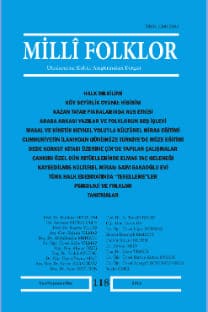Masallar Üzerinden Kutsal Söyleme Bakış
The Sacred Speech in the Landscape of Tales
___
- La princesse et l’oiseau», Bouali, Sid-Ahmed. Alger, éd, Enal.1983.
- Caftan d’amour tacheté de passion», El Fasi, Mohammed et Dermenghem, Emile: contes fasis. Paris, Rieder, 1926.
- Bachelard, Gaston. Lautréamont. Paris: José Corti, 1939.
- Bachelard, Gaston. L’Eau et les Rêves. Essai sur l’imagination et la matière. Paris, José Corti, 1949.
- Blanchard, Robert. Interprétation de formes symboliques. Paris, Les Presses du Midi, 2002.
- Belmont, Nicole. Poétique du conte. Essai sur le conte de tradition orale. Gallimard, 1999.
- Chelebourg, Christian. L’Imaginaire littéraire. Des archétypes à la poétique du sujet. Paris, Nathan, 2000.
- Chevalier, Jean, & Cheerbant, Alain. Dictionnaire des symboles : Mythes, rêves, coutumes, gestes, formes, figures, couleurs, nombres. Paris, Jupiter, 1983.
- Corbin, Henry. L’Imagination créatrice dans le soufisme d’Ibn’Arabi. Paris: Flammarion, 1958.
- Desclee de Brouwer. La Bible de Jérusalem. Paris. (Genèse 2 : 1-2) ; Collectif – Ecole Biblique De Jérusalem, 1999.
- Dermenghem, Emile. Le mythe de Psyché dans le folklore nord-africain. Alger, Revue Africaine n°402-403, p. 41-81.1945.
- Frazer, James-Georges. [1915]. Le Rameau d’or. Tome 1. Paris, Robert Laffont, collection «Bouquins», 1981.
- Guenon, René. Aperçus sur l’ésotérisme islamique et le Taoïsme. Paris, Gallimard, collection «Les essais», 1973.
- Held, Jacqueline. L’imaginaire au pouvoir. Les enfants et la littérature fantastique. Paris, Les Éditions Ouvrières, collection «Enfance heureuse», 1977.
- Jung, Carl, Gustav. L’Homme à la découverte de son âme. Paris, Payot, 1963.
- Leconte, Gérard. Ibn’Arabi : Les Soufis d’Andalousie. Version française de la traduction anglaise de R. W. J. Austin. Paris, Éditions Sindbad, 1979.
- Masson, Denise. Essai d’interprétation du CORAN inimitable. Traduction par Denise Masson, revue par Dr. Sobhi El-Saleh. Le Caire : Dar Al-Kitab Al-Masri / Beyrouth : Dar Al-Kitab Allubnani, 1980.
- Caillois, Roger. L’homme et le sacré. Paris, Gallimard, 1988.
- https://islamqa.info/fr/5142. Rapporté par al-Boukhari, (3047) et Mouslim (819).
- http://www.persee.fr/doc/assr_0003-9659_ 1959_.H.Corbin: «L’imagination créatrice dans le soufisme d’Ibn Arabi» Dousset.R. Archive des sciences sociales des religions, année 1959, volume7, numéro 1.
- ISSN: 1300-3984
- Yayın Aralığı: 4
- Başlangıç: 1989
- Yayıncı: Geleneksel Yayıncılık Eğitim San. Tic. Ltd. Şti.
İCAZET MERASİMİNDEN MEZUNİYET TÖRENİNE: BİR GEÇİŞ DÖNEMİ RİTÜELİNDE SÜREKLİLİK VE DEĞİŞİM
BİR MODERNİST’İN MİTOLOJİK HÂLLERİ: TANPINAR ESTETİĞİNDE AĞAÇ METAFORU ÜZERİNE MİTOPOETİK BİR OKUMA
MİLLÎ FOLKLOR DERGİSİ 2019 YILI YUVARLAK MASA TOPLANTISI
M. Öcal OĞUZ, Selcan GÜRÇAYIR TEKE, Tuna YILDIZ
OSMANLI TARİH YAZICILIĞINDA DESTANSI BİR KARAKTER: KANCA NÂM DİLAVER
Türkiye’de Tasarımcılar ve Zanaatkârlar Arasında Bilgi Paylaşımı: Bir Platformun Gelişimi
Çiğdem KAYA PAZARBAŞI, Pınar ÖZEMİR, Ersegün ERCİŞ
Masallar Üzerinden Kutsal Söyleme Bakış
GELENEKSEL KÜLTÜRDEKİ DOKUMANIN GÜNCELLENMESİ: GAZİANTEP KUTNU KUMAŞI ÖRNEĞİ
KÖROĞLU ANLATISININ HASAN BEY KOLU SÜLEYMAN USTA VERSİYONU
Cemal KURNAZ, Bir Köy Vardı. Ankara: Kurgan Edebiyat, 2018, ISBN:978-605-203064-6, 492 Sayfa.
